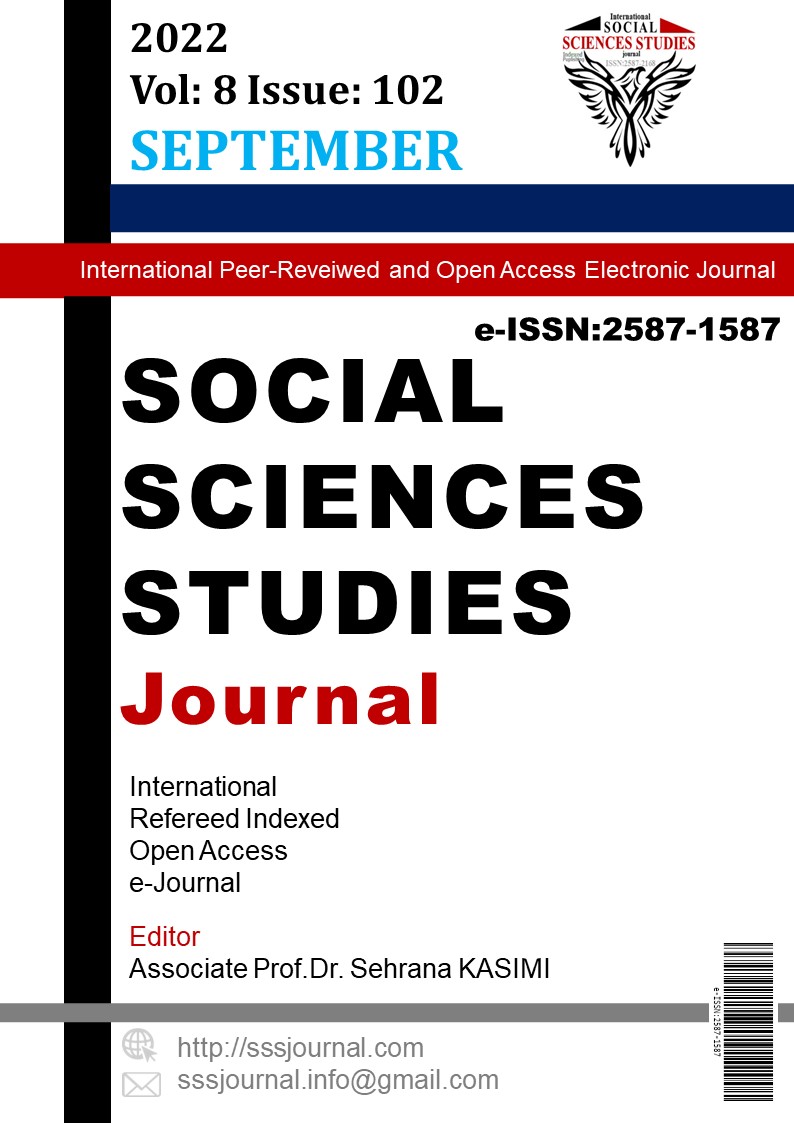Author :
Abstract
Sanat üretimi en temel anlamıyla düşünsel ve alanına göre bu düşüncenin varoluşa geçtiği bir uygulama olarak iki edim şeklinde gerçekleşmektedir. İlkinde beyin, ikincisinde ise el ve göz üretime hâkimdir. Bu süreç, eserin üretim aşamalarında sürekli devinir durur. Bazen düşünsel bir kıvılcım uygulamayı tetiklerken bazen de bir uygulama yeni bir düşünsel tavrı doğurur. Bu çalışmada, genel olarak sanat üretimini bu bağlamda tanımladıktan sonra Deleuze’un Bacon resimleri üzerinden kurduğu duyumsamaya dayanan el ve beynin resim üretimindeki etkisi üzerine odaklanılmıştır. “Bir ressam hangi dürtülerle tuvalin başına geçer ve üretir?” Bu sorudan hareketle Deleuze soyut, soyut dışavurumculuk ve nihayetinde Bacon’un duyumsamaya dayanan figür resmi üzerinden karşılaştırmalarla resmin üretimini yeniden kurguladığı, diyagramlara dayanan sanat tanımına odaklanılmıştır. Bu tanım bir şablon olmanın aksine, şablonları parçalayan bir üretim mantığı ortaya koymaktadır. Bu açıdan “resmin öldüğü” tezlerinin hâkim olduğu güncel sanat dünyasında, resmin insanın sinir sistemi ile ilişkisi ortaya konulmaya çalışılmış ve resmin imkânlarının sorgulanması amaçlanmıştır. Sanatın düşünsel bir dil ürünü olmaktan öte, insanın belki de ilkel denilebilecek dürtüleri ile ilişkisi ortaya konulmaya çalışılmış ve bu dürtülere bağlı bir üst dil olması düşüncesi ortaya atılmıştır. Elin bir makine gibi kusursuz hale geldiği sayısız pratiklerden sonra beynin yani düşüncenin -hatta süreç ilerledikçe belki sorgulama da diyebiliriz buna-, üretim sürecine dâhil olmasıyla zanaattan evrilen sanat üretiminin Rönesans’tan başlayarak günümüze kadar gelişindeki dönüşümlerini bu tartışmanın sınırları olarak belirlenmiştir.
Keywords
Abstract
Art production takes place in the form of two acts, intellectual in its most basic sense and as an application in which this thought comes into existence according to its field. In the first, the brain, in the second, the hand and eye dominate the production. This process is constantly moving during the production stages of the work. Sometimes an intellectual spark triggers the application, and sometimes an application creates a new intellectual attitude. In this study, after defining the production of art in this context in general, it is focused on the effect of the hand and brain on the production of painting, which is based on the sensation that Deleuze built on Bacon's paintings. “With what impulses does a painter go to the canvas and produce?” Based on this question, Deleuze focused on abstract, abstract expressionism, and finally Bacon's definition of art based on diagrams, in which he reconstructed the production of painting with comparisons over sensuous figure painting. Rather than being a template, this definition reveals a production logic that breaks the templates. In this respect, in the contemporary art world dominated by the theses of "painting is dead", the relationship between painting and human nervous system has been tried to be revealed and it is aimed to question the possibilities of painting. Beyond being a product of intellectual language, the relationship between art and human instincts, which can be called primitive, has been tried to be revealed, and the idea of a metalanguage based on these impulses has been put forward. The boundaries of this discussion are the transformations of art production, which evolved from craftsmanship, starting from the Renaissance to the present, with the involvement of the brain, that is, thought, perhaps even questioning as the process progresses, and its involvement in the production process, after countless practices in which the hand becomes perfect like a machine.
Keywords
- Arnheim, R. (2012). Görsel Düşünme, Çev: R. Öğdül, Metin Yayınevi, İstanbul.
- Arnheim, R. (2012). Görsel Düşünme, Çev: R. Öğdül, Metin Yayınevi, İstanbul.De Bolla, P. (2012). Sanat ve Estetik, Çev: K. Koş, Ayrıntı Yayınları, İstanbul. Colebrook, C. (2001). Gilles Deleuze, Routledge, London.
- Deleuze, G. (1981). L’image-mouvement, Minuit, Paris.
- Deleuze, G. (2009). Francis Bacon Duyumsamanın Mantığı, Çev: C. Batukan, E. Erbay, Norgunk Yayıncılık, İstanbul.
- Deleuze, G. (2017). Fark ve Tekrar, Çev. B. Yalım & E. Koyuncu, Norgunk Yayıncılık, İstanbul.Deleuze, G., Guattari, F. (2020). Felsefe Nedir? Çev. T. Ilgaz, Yapı Kredi Yayınları, İstanbul.
- Erdinç, Z. (2015). “Madde Kökenli Sanat İmgesi”, Hacettepe Üniversitesi Güzel Sanatlar Fakültesi Sanat Yazıları, 0(33): 269-287.
- Er, S. E., Çelik, F., Saldıray, Ö., Dündar, S., (2020). “Temsili Yıkmak: Deleuze’ün Resim Ontolojisine Bir Giriş”, Beytulhikme Int J Phil, 10(4): 1513-1536.
- Goodchild, P. (2005). Deleuze & Guattari Arzu Politikasına Giriş, Çev. R. D. Öğdül, Ayrıntı Yayınları, İstanbul.Grosz, E. (2009). Sensation: The Earth, a People, Art. Ed. E. W. Holland & D. W. Smith & C. J. Stivale, Gilles Deleuze: Image and Text, ss. 81–103, Continuum, London.
- Lyotard, J., F. (1994). Postmodern Nedir Sorusuna Cevap, Ed. Necmi Zeka. Postmodernizm, ss. 45-58, Kıyı Yayınları, İstanbul.
- Lyotard, J. F. (1991). The Inhuman: Reflections on Time. (Çev. G. Bennington ve R. Bowlby). California: Stanford University Press.
- Nietzsche, F. (2016). Böyle Söyledi Zerdüşt, Çev. M. Tüzel, Türkiye İş Bankası Kültür Yayınları, İstanbul. Platon, (2005). Devlet, Çev. S. Eyüboğlu, M.A. Cimcoz, Türkiye İş Bankası Yayınları, İstanbul.
- Sauvagnargues, A. (2010). Deleuze ve Sanat, Çev. N. Sarıca, De Ki Yayınları, Ankara.
- Sennett, R. (2009). Zanaatkar, Çev. M. Pekdemir, Ayrıntı Yayınları, İstanbul.
- Shiner, L. (2010). Sanatın İcadı, Çev. İ. Türkmen, Ayrıntı Yayınları, İstanbul.
- Yılmaz, M. (2001). Sanatçıları Okumak ya da Hayali Söyleşiler, Ütopya Yayınevi, Ankara.
- Watzlawick, P., Bavelas, J., B., Jackson, D., D., (2011). Pragmatics Of Human Communication : A Study Of İnteractional Patterns, Pathologies, And Paradoxes. Norton & Company, Inc., New York.
- Görsel 1. https://en.wikipedia.org/wiki/No._3/No._13_(Magenta,_Black,_Green_on_Orange) Erişim Tarihi: 08.06.2022
- Görsel 2. https://tr.m.wikipedia.org/wiki/Dosya:Malevich.black-square Erişim Tarihi: 10.06.2022Görsel 3. https://www.wikiart.org/en/paul-cezanne/bibemus-quarry Erişim Tarihi: 12.06.2022
- Görsel 4. https://www.wikiart.org/en/piet-mondrian/broadway-boogie-woogie-1943 Erişim Tarihi: 19.06.2022 Görsel 5. https://www.wikiart.org/en/jackson-pollock/number-5-1948-1 Erişim Tarihi: 23.06.2022
- Görsel 6. https://www.francis-bacon.com/artworks/paintings/three-studies-crucifixion Erişim Tarihi: 23.06.2022 Görsel 7. https://www.francis-bacon.com/artworks/paintings/study-head Erişim Tarihi: 23.06.2022





